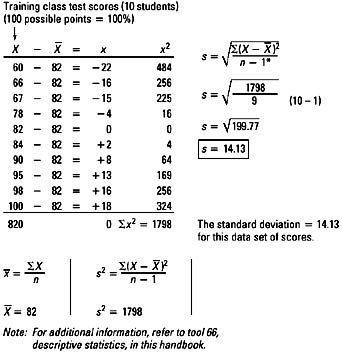Tool 184: Standard Deviation
| AKA | N/A |
| Classification | Analyzing/Trending (AT) |
Tool description
The standard deviation is a powerful building block to perform descriptive and inferential statistics in research, project management, quality assurance, education and training, and many other disciplines. Used in many statistical formulae, it assists in the understanding of variability in data distributions. Considered a unit of measurement, a smaller standard deviation simply states that the data distribution is more homogeneous or has less variance.
Typical application
-
To identify the extent of variability in a data set.
-
To assist in statistical analyses such as process capability, analysis of variance (anova), design of experiments, and others.
-
To compare two or more data distributions.
Problem-solving phase
| Select and define problem or opportunity | |
| → | Identify and analyze causes or potential change |
| Develop and plan possible solutions or change | |
| Implement and evaluate solution or change | |
| → | Measure and report solution or change results |
| Recognize and reward team efforts |
Typically used by
| 1 | Research/statistics |
| Creativity/innovation | |
| 2 | Engineering |
| Project management | |
| 3 | Manufacturing |
| 4 | Marketing/sales |
| Administration/documentation | |
| Servicing/support | |
| Customer/quality metrics | |
| 5 | Change management |
before
-
Data Collection Strategy
-
Observation
-
Questionnaires
-
Surveying
-
Frequency Distribution (FD)
after
-
Process Capability Ratios
-
Correlation Analysis
-
Normal Probability Distribution
-
Control Chart
-
Analysis of Variance
Notes and key points
-
Definition: The standard deviation is a measure of variability within a population or a sample of data. A more technical definition describes the standard deviation as the square root of the average of the squared deviations of the observations from the mean


-
Normal probability distribution

-
Also refer to tool 119, normal probability distribution, in this handbook.
Step-by-step procedure
-
STEP 1 First, collected scores are sequenced from the lowest to the highest score and placed into a table. See example Calculating the Standard Deviation—Test Scores.
-
STEP 2 Calculate the mean
 and subtract from all scores.
and subtract from all scores. -
STEP 3 Check that the sum of - and + deviation scores (x) = 0.
-
STEP 4 Square deviation scores and total.
-
STEP 5 Calculate the variance (S2). Remember, use n-1 is total scores are less than 30.
-
STEP 6 Take the square root of the variance to get the standard deviation.
Example of tool application
Calculating the Standard Deviation—Test Scores

EAN: 2147483647
Pages: 326
- Step 1.2 Install SSH Windows Clients to Access Remote Machines Securely
- Step 2.1 Use the OpenSSH Tool Suite to Replace Clear-Text Programs
- Step 4.3 How to Generate a Key Pair Using OpenSSH
- Step 4.7 Using Public Key Authentication for Automated File Transfers
- Step 5.2 Troubleshooting Common OpenSSH Errors/Problems